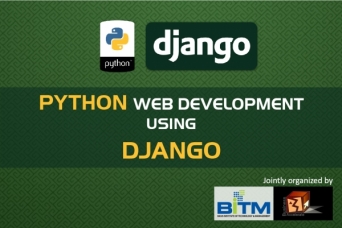- +8809612342486
- [email protected]

Python is one of the best programming languages in the planet. Reasons: It's proven & scalable, It's open-source, The Internet of Things and Raspberry Pi, It's leading the change for future technology
This training is jointly organized by BITM & Business Accelerate BD Ltd.
Training will be held in Business Accelerate BD Ltd.
Early bird Registration: 20,000/- Last Date: 5 July 2018
If you work with Python, the chances are good you need internet-connected data that stored securely and is reliable. This is where Django comes in. Django is a web-framework that can handle all of your data and handle it better than any web framework out there.
Django is the #1 Web Framework for Python for a reason: it's easy enough for the beginners and yet powerful enough for the pros. Instagram uses Python by way of Django. So does Pinterest. And Nasa. And Mozilla. It may not be the only technology that they use but its... the backbone of them all.
If Python is the future behind underlying technology, Django will be it's close cousin and if you love Python, Django will soon become your friend.
COURSE CURRICULUM
Section 1: Python Programming Language
1. Getting Started With Python
History of Python
Python Versions
Installation
Why to use Python?
Using the Interpreter
IDLE
Running a Python Script
Python Editors and IDEs
Variables, Keywords
Naming Conventions
Built-in Functions
Getting Help
2. Basic Python Concepts
Mathematical Operations
Comments
Strings
Performing operations on a string
String Formatting
Numeric Data Types
Type Conversion
3. Flow Control
Indenting is significant
Booleans
Comparison Operators
if Statement
elif Statement
else Statement
while loop
for loop
range() function
break and continue
4. Functions
Syntax of function definition
Parameters
Documentation Strings
Keyword and Optional Arguments
Global versus local variables
Passing Collections to a Function
Variable Number of Arguments
Passing Functions as arguments
Lambda
5. Collections
Lists
Tuples
Sets
Dictionaries
Indexing and Slicing
Iterating through a collection
6. Modules
Import Statement
The from ... import statement
Module Search Path
Making Your Own Modules
Standard Modules - sys
Standard Modules - time
The dir Function
7. Exception Handling
Errors
Exceptions
Handling Exceptions
Raising Exceptions
Try ... Finally
assert
Writing Your Own Exception Classes
8. Input and Output
Access Modes
Reading Data From a File
Writing Data to a File
Handling IO Exceptions
9. Implementing Classes and Objects
Defining Classes
Inheritance
Initializers
Instance Methods
Properties
Class Methods and Data
Static Methods
Private Methods
Operator Overloading
Encapsulating attributes and methods in classes
class decorators
10. Regular Expression
Regular Expression Syntax
Building Blocks
Grouping
11. Other Things To Know
Iterator
Generators
Decorators
The Python Debugger
Logging
Context Managers ("with" statement)
Comprehensions
Python package manager (pip)
Virtual environments
Section 2: Django Framework
1. Getting Started With Django
Introduction
How Web works
Setting up the development environment
Installation
Django project
Django application
Running the server
2. Django URL Patterns
What are URLs?
URL Dispatcher
Directory Structure
MVC Applied to Django and Git
Request Life Cycle
URL patterns
URL Patterns Configuration
Shortcuts and Handling 404s
3. Django views
How to create Django views?
About View Functions
Using Django's HttpResponse Class
Understanding HttpRequest Objects
Function Based Views
Class Based Views
CRUD Generic views
View Decorators
Mixins
Messages (flash message)
4. Django Templates
Template Language
Template Inheritance
Template Filters
Creating Custom Template Filters
Relative URLS
Static & Media files
Twitter bootstrap integration
5. Django Models & ORM
Models Overview
Creating Models
Model Manager
Migration
Providing initial data (fixtures)
Playing with the data
Making Queries
Understanding QuerySets
Common QuerySet Methods
Managing Related Records
Retrieving Related Records
Complex lookups with Q objects
Aggregation
Search
Performing raw SQL queries
6. Django Admin
Creating a super user
Accessing models from the admin site
Customizing the admin site
Adding related models
Ordering Fields
7. Django Forms
Django’s role in forms
Building Form
Building ModelForm
Working with form templates
Built-in Validators
Writing Validators
8. Django Middleware
Available Middleware
Writing your own middleware
Activating Middleware
Ordering
9. Django Authentication
User Model
User Manager
Password Hashing
Password Validators
Permissions and Authorization
Authentication Views
Built-in forms
Registration
Login
Password Reset
Restricting Access
10. Django Cache
Setting Up the Cache
Usage
Versioning
11. Writing reusable apps
Installing some prerequisites
Packaging app
Using own package
Publishing app
12. Django Deployment
Introduction to Django Deployment
Setting Up Gitlab
Deployment Workthrough
13. You should also know
Django Management Commands
Django Debug Toolbar
Using Logging
Configuring Logging
File Upload, Handling Ajax request
Configuring Mail Settings
Sending email
Outputting PDFs with Django
Django Signals
Section 3: Final Project
| Theory + Practical | Final Project | 18 Hrs |
| Theory + Practical | Django Framework | 64 Hrs |
| Theory + Practical | Python Programming Language | 26 Hrs |